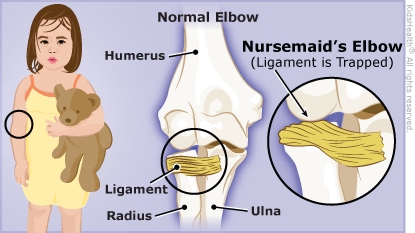Nursemaid's Elbow: How to Care for Your Child
Nursemaid's elbow happens when a ligament (a stretchy band that joins two bones) gets trapped. Sometimes it gets unstuck by itself. In most cases, a health care professional gets the ligament back in place by doing a quick, gentle move of the arm. To help prevent nursemaid's elbow, always pick up your child from under the armpits and not by the hands or arms.


-
Don't swing or lift your child by the lower arm, hands, or wrists. Always pick up your child from under the armpits.
-
Be sure to tell caretakers that your child has had nursemaid's elbow and show them how to lift your child from under the armpits.
-
If your child has pain, a medicine may help. If your health care professional says it's OK, use these medicines exactly as directed:
-
acetaminophen (such as Tylenol® or a store brand)OR
-
ibuprofen (such as Advil®, Motrin®, or a store brand). Do not give to babies under 6 months old.

Your child:
-
Is not using the arm normally.
-
Still has elbow pain after you've given pain medicine.
-
Gets another elbow injury.


How do kids get nursemaid's elbow? Young kids have ligaments that are a bit loose. Sometimes during play or when a child is lifted by the arm, two bones in the elbow can briefly separate a little bit, letting a ligament slip into the joint and get stuck. As kids get older, the ligaments tighten. Most won't get nursemaid's elbow after they turn 5 years old, though it can happen up to age 6 or 7.
How do health care professionals diagnose nursemaid's elbow? Health care professionals are trained to examine a child's arm and ask questions about how the injury happened. They usually don't need to do any special tests to diagnose nursemaid's elbow.
Can kids get nursemaid's elbow more than once? Yes. To help prevent it, parents and caregivers should never pull, tug, or swing a child by the arms or hands. Some kids, though, are just more likely to get nursemaid's elbow, and might get it again even when parents try hard to prevent it.